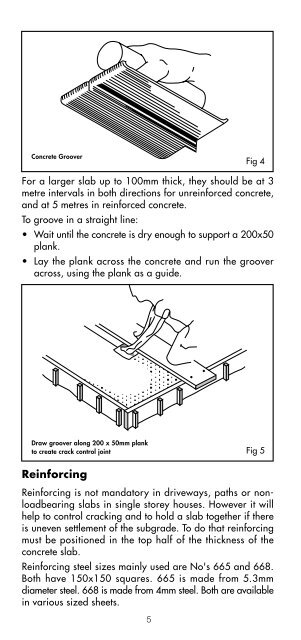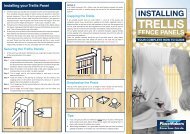Working with concrete. - PlaceMakers
Working with concrete. - PlaceMakers
Working with concrete. - PlaceMakers
You also want an ePaper? Increase the reach of your titles
YUMPU automatically turns print PDFs into web optimized ePapers that Google loves.
Concrete Groover<br />
Fig 4<br />
For a larger slab up to 100mm thick, they should be at 3<br />
metre intervals in both directions for unreinforced <strong>concrete</strong>,<br />
and at 5 metres in reinforced <strong>concrete</strong>.<br />
To groove in a straight line:<br />
• Wait until the <strong>concrete</strong> is dry enough to support a 200x50<br />
plank.<br />
• Lay the plank across the <strong>concrete</strong> and run the groover<br />
across, using the plank as a guide.<br />
Draw groover along 200 x 50mm plank<br />
to create crack control joint<br />
Fig 5<br />
Reinforcing<br />
Reinforcing is not mandatory in driveways, paths or nonloadbearing<br />
slabs in single storey houses. However it will<br />
help to control cracking and to hold a slab together if there<br />
is uneven settlement of the subgrade. To do that reinforcing<br />
must be positioned in the top half of the thickness of the<br />
<strong>concrete</strong> slab.<br />
Reinforcing steel sizes mainly used are No's 665 and 668.<br />
Both have 150x150 squares. 665 is made from 5.3mm<br />
diameter steel. 668 is made from 4mm steel. Both are available<br />
in various sized sheets.<br />
5
















